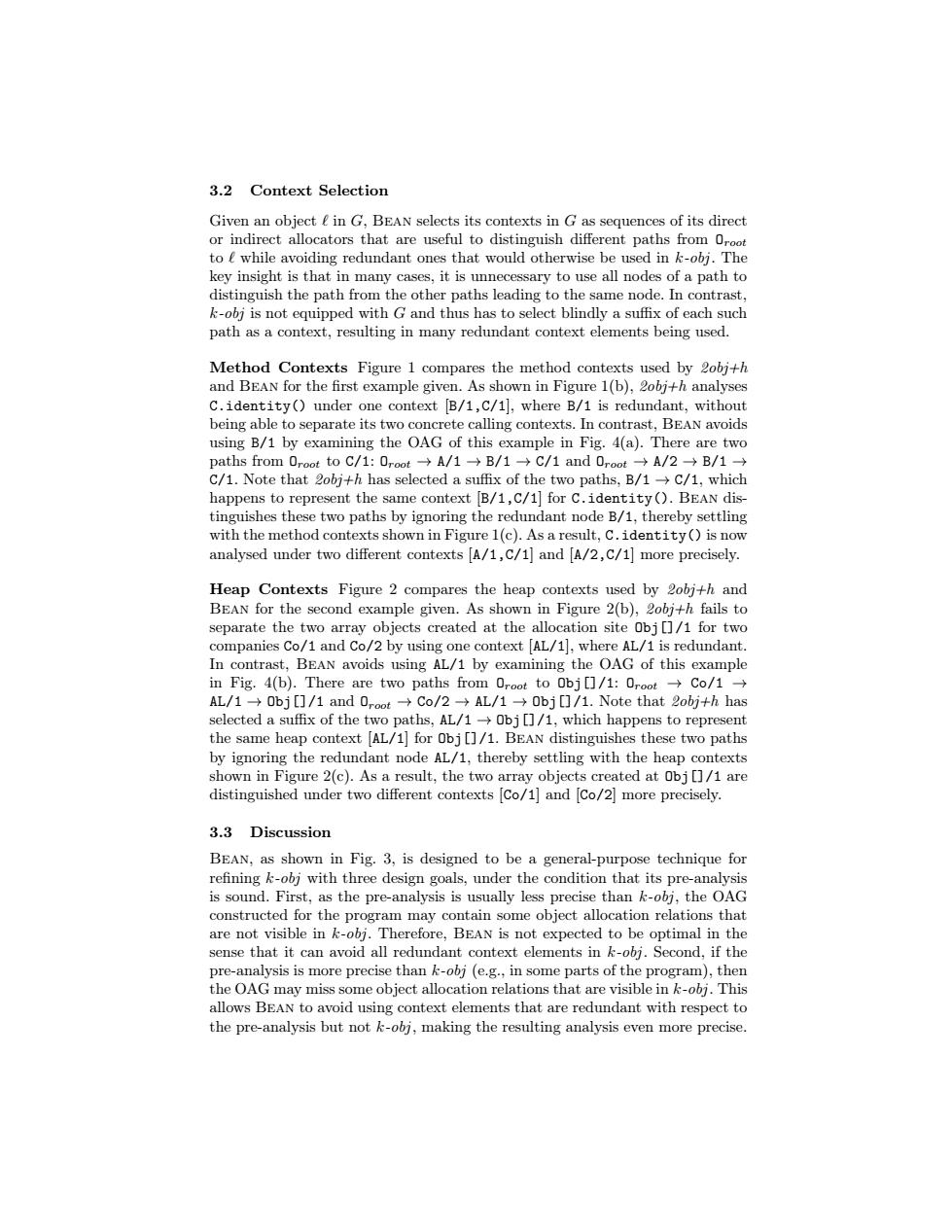正在加载图片...

3.2 Context Selection Given an object e in G,BEAN selects its contexts in G as sequences of its direct or indirect allocators that are useful to distinguish different paths from Oroot to e while avoiding redundant ones that would otherwise be used in k-obj.The key insight is that in many cases,it is unnecessary to use all nodes of a path to distinguish the path from the other paths leading to the same node.In contrast, k-obj is not equipped with G and thus has to select blindly a suffix of each such path as a context,resulting in many redundant context elements being used. Method Contexts Figure 1 compares the method contexts used by 2obj+h and BEAN for the first example given.As shown in Figure 1(b),2obj+h analyses C.identity()under one context B/1,C/1],where B/1 is redundant,without being able to separate its two concrete calling contexts.In contrast,BEAN avoids using B/1 by examining the OAG of this example in Fig.4(a).There are two paths from0 root to C/1:0root→A/1→B/1→C/1and0root→A/2→B/1→ C/1.Note that 2obj+h has selected a suffix of the two paths,B/1-C/1,which happens to represent the same context [B/1,C/1]for C.identity().BEAN dis- tinguishes these two paths by ignoring the redundant node B/1,thereby settling with the method contexts shown in Figure 1(c).As a result,C.identity()is now analysed under two different contexts [A/1,C/1]and [A/2,C/1]more precisely. Heap Contexts Figure 2 compares the heap contexts used by 2objth and BEAN for the second example given.As shown in Figure 2(b),2obj+h fails to separate the two array objects created at the allocation site Obj[]/1 for two companies Co/1 and Co/2 by using one context [AL/1],where AL/1 is redundant. In contrast,BEAN avoids using AL/1 by examining the OAG of this example in Fig.4(b).There are two paths from Oroot to Obj[]/1:Oroot Co/1 AL/1→0bj[☐/1and0root→Co/2→AL/1→0bj[0/1.Note that2ob+hhas selected a suffix of the two paths,AL/1-Obj[]/1,which happens to represent the same heap context [AL/1]for Obj[]/1.BEAN distinguishes these two paths by ignoring the redundant node AL/1,thereby settling with the heap contexts shown in Figure 2(c).As a result,the two array objects created at Obj[]/1 are distinguished under two different contexts [Co/1]and [Co/2]more precisely. 3.3 Discussion BEAN,as shown in Fig.3,is designed to be a general-purpose technique for refining k-obj with three design goals,under the condition that its pre-analysis is sound.First,as the pre-analysis is usually less precise than k-obj,the OAG constructed for the program may contain some object allocation relations that are not visible in k-obj.Therefore,BEAN is not expected to be optimal in the sense that it can avoid all redundant context elements in k-obj.Second,if the pre-analysis is more precise than k-obj(e.g.,in some parts of the program),then the OAG may miss some object allocation relations that are visible in k-obj.This allows BEAN to avoid using context elements that are redundant with respect to the pre-analysis but not k-obj,making the resulting analysis even more precise.3.2 Context Selection Given an object ` in G, Bean selects its contexts in G as sequences of its direct or indirect allocators that are useful to distinguish different paths from Oroot to ` while avoiding redundant ones that would otherwise be used in k-obj. The key insight is that in many cases, it is unnecessary to use all nodes of a path to distinguish the path from the other paths leading to the same node. In contrast, k-obj is not equipped with G and thus has to select blindly a suffix of each such path as a context, resulting in many redundant context elements being used. Method Contexts Figure 1 compares the method contexts used by 2obj+h and Bean for the first example given. As shown in Figure 1(b), 2obj+h analyses C.identity() under one context [B/1,C/1], where B/1 is redundant, without being able to separate its two concrete calling contexts. In contrast, Bean avoids using B/1 by examining the OAG of this example in Fig. 4(a). There are two paths from Oroot to C/1: Oroot → A/1 → B/1 → C/1 and Oroot → A/2 → B/1 → C/1. Note that 2obj+h has selected a suffix of the two paths, B/1 → C/1, which happens to represent the same context [B/1,C/1] for C.identity(). Bean distinguishes these two paths by ignoring the redundant node B/1, thereby settling with the method contexts shown in Figure 1(c). As a result, C.identity() is now analysed under two different contexts [A/1,C/1] and [A/2,C/1] more precisely. Heap Contexts Figure 2 compares the heap contexts used by 2obj+h and Bean for the second example given. As shown in Figure 2(b), 2obj+h fails to separate the two array objects created at the allocation site Obj[]/1 for two companies Co/1 and Co/2 by using one context [AL/1], where AL/1 is redundant. In contrast, Bean avoids using AL/1 by examining the OAG of this example in Fig. 4(b). There are two paths from Oroot to Obj[]/1: Oroot → Co/1 → AL/1 → Obj[]/1 and Oroot → Co/2 → AL/1 → Obj[]/1. Note that 2obj+h has selected a suffix of the two paths, AL/1 → Obj[]/1, which happens to represent the same heap context [AL/1] for Obj[]/1. Bean distinguishes these two paths by ignoring the redundant node AL/1, thereby settling with the heap contexts shown in Figure 2(c). As a result, the two array objects created at Obj[]/1 are distinguished under two different contexts [Co/1] and [Co/2] more precisely. 3.3 Discussion Bean, as shown in Fig. 3, is designed to be a general-purpose technique for refining k-obj with three design goals, under the condition that its pre-analysis is sound. First, as the pre-analysis is usually less precise than k-obj, the OAG constructed for the program may contain some object allocation relations that are not visible in k-obj. Therefore, Bean is not expected to be optimal in the sense that it can avoid all redundant context elements in k-obj. Second, if the pre-analysis is more precise than k-obj (e.g., in some parts of the program), then the OAG may miss some object allocation relations that are visible in k-obj. This allows Bean to avoid using context elements that are redundant with respect to the pre-analysis but not k-obj, making the resulting analysis even more precise